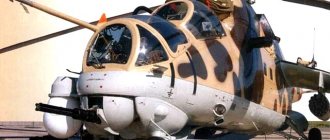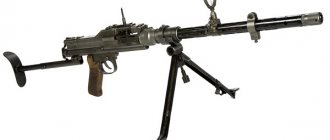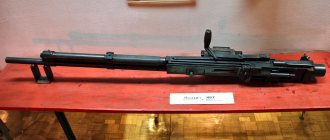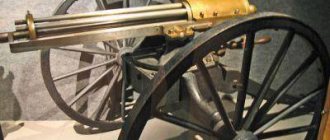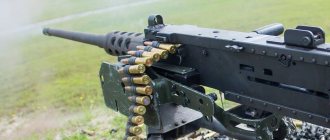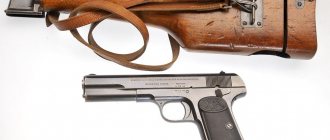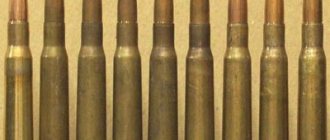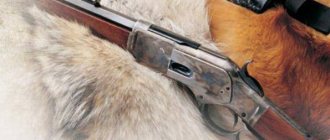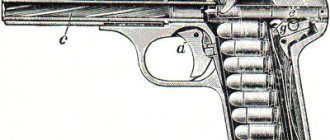Machine gun M1895/1914 "Colt"
John M. Browning developed his own machine gun design in 1889. As a basis, he took a scheme with air cooling of the barrel and removal of powder gases. At the same time, Browning decided not to use gas outlets and made the piston swing. As a result, the machine gun turned out to be relatively light. In 1890, Browning sold the rights to manufacture the machine gun, which in 1895 produced a machine gun called the Colt M1895. The American military department purchased these machine guns in small quantities. In addition, they were sold to Great Britain (at the beginning of the war they were used as training ones), Italy, Spain and some Latin American countries. Before World War I, the M1895/1914 modification was created, which had a weighted barrel without fins. Russia was perhaps the main large buyer of the Colt machine gun - it became the second most popular (after Maxim) machine gun in the Russian army.
The gas exhaust engine was of an original design. Powder gases, after passing through an open hole in the barrel wall from below, threw out a piston mounted on the end of a long arm of a connecting rod - a swinging crank lever. The connecting rod, turning 170 degrees, set in motion the crank (second lever), connected to the bolt through a sliding bar. The bar (bolt frame) was the leading link of the system. She, moving back, influenced the protrusion of the shutter with a figured cutout. After lowering, the rear part of the bolt came out of engagement with the supporting surface of the receiver - the barrel bore was unlocked. The bar, continuing to move, pulled the bolt back, and the spring-loaded bolt ejector removed the cartridge case from the chamber. The sleeve hit the tooth of the receiver liner sliding in the bolt groove and was pushed to the right through the outlet window in the receiver. At the same time, a pair of return springs mounted in tubes under the barrel were compressed. Hinged earrings and rods connected the springs and the short arm of the connecting rod, turned it forward, returning the moving system to its original position, the bolt sent a cartridge into the chamber, and if the trigger was pressed, the next shot was fired. The stroke length of the system was 102 millimeters. Due to the characteristic movement of the piston and the dust raised by the gases vented downwards, the M1895/1914 Colt machine gun received the nickname “Potato Digger” - “potato digger”. There was an opinion that the intake of air after each shot improved the cooling of the barrel, but in reality this only ensured that the gas outlet was purged.
A hammer firing mechanism with a screw mainspring and straight-line movement of the trigger was installed in the tubular butt plate. The trigger mechanism included a self-timer and an open trigger. A safety lever was installed on the right side, which locked the trigger. The reloading handle was located under the piston at the end of the connecting rod. A cord was manually tied to this reloading handle; its other end was attached to the butt plate. However, there was a more convenient scheme, which had a swinging lever and a block. There was a control handle on the butt plate.
The machine gun was powered by a canvas cartridge belt capable of holding 100 rounds. The power system included a drum-type receiver driven by a sliding bar, a extractor, and a cartridge supply device. The drum had two teeth - the front one grabbed the cartridge in the belt by the bullet, the back one by the cartridge case. The swinging feed lever rotated the drum. The lever was attached to the right wall of the receiver and connected by a swinging feeder. Turning the drum to the right was not allowed by a special pawl. The cartridge passed into the chamber from the tape as follows. As the bar moved backwards, its protrusion pressed on the tail of the feeder, which drove the feed lever. The feeder tail jumped over the drum tooth without rotating it. During the reverse movement, the slats of the part rotated in reverse, while the tooth of the feed lever rotated the drum one step, and the cartridge ended up in front of the receiver window. The cartridge was removed from the tape by the edge using a spring-loaded extractor. The extractor was mounted on a bar and moved the cartridge to the feeder tray. After the cartridge was completely removed from the belt, the ridge of the bar pressed on the pawl of the tray, which raised the cartridge until it exited the frame window, the extractor at that time released the cartridge, and the tray stopped moving so as not to interfere with the removal of the spent cartridge case. During the reverse movement, the bar rotated the tray, while the cartridge moved into the receiving window of the receiver, where it was picked up by the bolt. The comb, when the cartridge entered the chamber, released the tray pawl, and the tray lowered. The protrusion of the bar pressed on the feeder, and the next cartridge was fed by the drum. The design of the machine gun had 137 parts.
The machine gun was mounted on a tripod machine, which consisted of a base to which one rear and two front legs were attached (hinged), a swivel, a swinging part, and a worm mechanism with a gear arc for vertical aiming. The body of the machine gun was installed on the platform of the swinging part using a bolt and an adjusting screw; the cartridge box holder was located on the left side of the platform. A rotating transverse bar was installed on the rear leg, which had supports for the elbows (“low” tripod) or a seat and a bag with spare parts (“high” tripod).
In August 1915, after testing the Colt Model 1914 machine gun at the Rifle Range of the Officer Rifle School, Major General Filatov, the head of the school, wrote: “It is very difficult for one person to load a machine gun... The variety of breakdowns, as well as their relatively large number, indicate low strength its parts." As often happened, the order from Russia required improvement of the model. For example, the first 1750 machine guns were supplied with a high so-called “French” tripod (such a tripod was supplied to France), and the slide was reinforced on them. General Sapozhnikov made significant efforts to ensure that Colt and Marlin began supplying “low” tripods. It turned out that the shields, whose dimensions were 685x445 millimeters, were more reliably made at the Izhora plant in Russia. 6.5 mm armor steel was used for them.
Machine guns of the “Russian order” were equipped with a folding frame sight, notched up to 2300 meters, with a diopter rear sight - the sight clamp had a disk with five diopter holes, which were selected depending on the illumination and range. The sight was equipped with a mechanism for introducing lateral corrections. The length of the aiming line was 855 millimeters.
The Colt machine gun also found its place in Russian aviation. On October 4, 1915, General Sapozhnikov purchased 67 Colt machine guns (7 mm caliber) and a million cartridges in England with a cash purchase specifically for aviation. On April 30, 1916, they were transferred to the Aeronautical Department of the State Technical University. However, soon after this, the GVTU returned some of the machine guns to the GAU so that they could be adapted to fire incendiary bullets.
At the end of 1915, a tripod with a seat, a replaceable copper drum with a tape, and a wooden butt-handle was offered for the Colt machine gun. This installation was not used in the infantry, but the butt and drum were appreciated in aviation - drums with fastenings, as well as bags for spent cartridges, were ordered from. The Russian-Baltic Carriage Works produced synchronous installations for “machine guns of the Vickers and Colt system.” In 1918, it released its own aviation modification of the machine gun (with a gas exhaust engine and linear piston movement), and later a tank version - this machine gun was not supplied to Russia.
The procedure for unloading the M1895/1914 Colt machine gun: Push the discharge button located on the right side of the box forward, releasing the feed drum. Pull the cartridge strip to the left.
The procedure for partial disassembly of the M1895/1914 Colt heavy machine gun: 1. Remove the barrel. To do this: the bloodworm is pulled down and back. While holding it in the final position, pull out the barrel latch located at the base of the gas chamber using a key screwdriver. Using the same key, insert its tooth into the slot on the barrel, unscrew and remove the barrel. Slowly lower the bloodworm. 2. The butt plate is separated. To do this, you need to turn the butt plate closure located on its right side with its tail back, take it out to the right, holding the control handle, pull the butt plate back by rocking it up and down. 3. The butt plate is disassembled. To do this: rest the automatic release tooth against a wooden support, press the trigger, and smoothly separate the parts. 4. The shutter is removed. To do this, it is necessary to move the crank to the rear extreme position and, holding it in this way, use the tail of the contactor to push the bolt axis through the hole in the left wall of the buttplate box; release the bolt and remove the bolt. 5. The shutter is disassembled. To do this, the striker pin is pushed out and the striker with the spring is removed. 6. The machine gun is separated from the machine. To separate, you need to turn the connecting bolt upward with the handle and remove it; the body of the machine gun is removed from the machine.
The machine gun is assembled in the reverse order.
Technical characteristics of the Colt heavy machine gun, model 1914 (M1895/1914 “Russian order”): Cartridge – 7.62 model 1908 (7.62×53); The weight of the machine gun “body” is 16.1 kg; The length of the machine gun “body” is 1050 mm; Barrel length – 700 mm; Rifling – 4 right-hand; Rifling stroke length – 240 mm; Initial bullet speed – 850 m/s; Sighting range – 2300 m; Rate of fire – 500 rounds per minute; Combat rate of fire - 200 rounds per minute; Belt capacity – 250 rounds; Type of machine – tripod (so-called “low tripod”); Machine weight – 23.9 kg; Shield weight – 12.4 kg; Vertical guidance angle – from -40 to +30 degrees; Horizontal guidance angle – 360 degrees; The height of the firing line is 494 mm.
Based on materials: S. Fedoseev - Machine guns in the First World War
Notes
- Julian S. Hatcher.
Hatcher's Notebook. - Stackpole Books, 1962. - P. 79–81. — ISBN 0-8117-0795-4. - United States Army.
Ordnance Dept., Herbert Treadwell Wade. Handbook of Ordnance Data. - 1919. - P. 307. - [browningmgs.com/Images_1919A4/Brownings.htm Browning Machine Guns].
- United States Navy Dept.
Annual Reports of the Navy Department: Report of the Secretary of the Navy. — Published by United States Government Printing Office, 1893. — P. 235. - Pavel Stolyarov. “Pig” Browning machine gun // “Master Gun” magazine, No. 54, 2001. pp. 18-21
- [www.jaegerplatoon.net/PISTOLS4.htm 7.62 mm Colt-Browning M/1895]
Links
Rifles and carbines Mosin rifle mod. 1891/1910 • Krnka rifle • Berdan rifle • Arisaka rifle mod. 1897 • Winchester rifle mod. 1895 • Winchester rifle mod. 1907 • German commission rifle mod. 1888 •
Mannlicher rifle mod.
1895 • Gra rifle / Gra-Kropachek • Lebel rifle mod. 1886 • Vetterli-Vitali rifle mod. 1870/87Machine guns and automatic rifles Fedorov automatic rifle • Madsen light machine gun • Maxim machine gun mod. 1910 • Vickers machine gun • Schwarzlose machine gun mod. 1907/12 • Light machine gun of the Shosha system mod.
1915 • Colt-Browning machine gun mod. 1895 • Hotchkiss machine gun mod. 1909 • Lewis machine gunGrenades Rdultovsky grenade mod. 1912 • Rdultovsky grenade model. 1914 • French F1 grenade Flamethrowers Backpack flamethrower Tovarnitsky mod. 1916 • Grobov backpack flamethrower mod. 1915 • Lawrence backpack flamethrower • Tilly-Gosko backpack flamethrower Ammo 7.63×25 mm Mauser • 7.62×38 mm Nagant • 7.62×54 mm R • .351 WSL • 6.5×50 mm Arisaka •
9×19 mm ParabellumItalic captured weapons that entered service with the RIA are noted
Rifles Springfield M1903 • Pedersen Rifle • M1917 Enfield • Berthier Rifle Light machine guns Chauchat Model 1915 • Browning M1918 • Lewis Shotguns and shotguns Winchester Model 1897 • Winchester Model 1912 • Browning Auto-5 • Remington Model 10 Machine guns Colt-Browning M1895 • M1909 Benet-Mercie • M1914 Hotchkiss • Browning M1917 Grenades • Mills grenade • Mk 1 • Mk 2 Ammo .45 ACP • .38 Special • .30-06 Springfield Rifles Fusil Berthier • Mousqueton Berthier • Chassepot M1866/74 • Gras M1874 • Kropatschek M1884 and M1885 • Lebel M1886 • Lee-Metford Mk I, Mk II • Meunier • Remington-Lee M1885 • Remington M8 • Remington Rolling Block • Ribeyrolles M1918 • RSC M1917 • Winchester M1894 • Winchester M1907 • Winchester M1910 Submachine guns Chauchat-Ribeyrolles M1918 Machine guns Chauchat Mle 1915 • Colt-Browning M1895/14 • Hotchkiss Mle 1909 • Hotchkiss Mle 1897/1900/1908/1914 • Puteaux Mle 1905 • St. Etienne Mle 1907 Anti-tank weapons Puteaux SA 18 Grenades Flamethrowers • • Schilt Mortars Crapouillot Crossbows Sauterelle Regimental guns Canon d'Infanterie de 37 modèle 1916 TRP Ammo 8x50mm R Lebel • .303 British • .32 ACP • 10.35x20mm • .380 ACP • .45 ACP • .38 Long Colt • 7x57mm Rifles Carcano Mod. 91 • Carcano Mod. 38 • Armaguerra Mod. 39 • Breda Mod. 1935 PG • Scotti Mod. X • Steyr Mannlicher M1895 Submachine guns Beretta M1918 • Beretta MAB 38 • Isotta Fraschini • OG-43 • Onorati • OVP • FNAB-43 • TZ-45 • Variara Machine guns Breda Mod. 5C • Breda Mod. 30 • Breda Mod. 31 • Breda Mod. 37 • Breda Mod. 38 • Breda-SAFAT • Fiat-Revelli Mod. 1914 • Fiat-Revelli Mod. 14/35 • Hotchkiss M1914 • Saint-Étienne M1907 • SIA Mod. 1918 • Colt-Browning M1895 • Schwarzlose M.07/12 Anti-tank rifles Maroszek wz. 35 • Solothurn S18-100 Grenade launchers Brixia M35 • 81/14 Modello 35 Grenades Breda Mod. 35 • Breda Mod. 40 • Breda Mod. 42 • OTO Mod. 35 • OTO Mod. 42 • SRCM Mod. 35 Flamethrowers Lanciafiamme Mod. 35 • Lanciafiamme Mod. 40 • Lanciafiamme Mod. 41 • Lanciafiamme Mod. 41 Mortars Brixia Mod. 35 • Mortaio da 81 Mod. 35 Ammo .32 ACP • .380 ACP • 7.65×17 mm • 9×17 mm • 9×19 mm Glisenti • 9×19 mm Parabellum • 10.35×20 mm • 6.5×52 mm Mannlicher-Carcano • 7 ,35×51 mm Carcano • 7.92×57 mm • 8×50 mm R Mannlicher • 8×59 mm RB Breda • 12.7×81 mm SR Breda • 13.2×96 mm
Users
- Australia
- Belgium
- Canada
- Czechoslovakia [22]
- Spain
- US
- Finland: Used during the Finnish Civil War and withdrawn from service in 1936. [23]
- France
- Greece
- Russian Empire: 14,850 M1895/1914 machine guns purchased. [24]
- Italy
- Mexico
- Poland
- First Philippine Republic
- Mutawakkilite Kingdom of Yemen [1]
- United Kingdom
- Romania [25]
- Uruguay
Interwar period and World War II
Polish soldiers with an M1895/M1914 machine gun during the Polish-Soviet War.
Battle of Blair Mountain, 1921; Marlin machine gun with a radiator mounted on the barrel on the left. After World War I, some Colt-Browning machine guns (possibly including Marlin M1917/18 variants) were used in the Russian Civil War. Their most notable use was during the exodus of the Czechoslovak Legion from Russia, when machine guns (either Colt-Browning M1895/14 or Marlin M1917) were photographed inside the sandbagging parapets on the roofs of train cars used by the Legion during its withdrawal from the Soviet Union . Russia. Some of these machine guns were also used in the Polish-Soviet War of 1920. At the start of World War II, the Marlin M1917 and Marlin M1918 machine guns were sent to the United Kingdom to equip the Home Guard, but were never used in combat.
The last recorded use of this machine gun in the United States was in 1921, when National Guard members engaged striking miners at the Battle of Blair Mountain, West Virginia. A contemporary photograph shows a Colt Browning equipped with one of the aforementioned Marlin-Rockwell aluminum radiators, issued by a National Guardsman in support of sheriff's deputies. The presence of a full barrel finned aluminum radiator indicates that this was likely a Marlin-Rockwell M1917/18 machine gun purchased by the Army between 1917 and 1918 for training, as the Army never purchased the Colt-Browning M1895/14 variant.
Due to service in the Spanish Army, the Colt-Browning was widely used by both sides during the Spanish Civil War. It was used with great success by the British battalion at the Battle of Jarama, however it often jammed and was not appreciated by the troops.
Romanian soldiers with two Colt-Browning M1895s, 1939.
Towards the end of the First World War, the Belgian Army purchased large numbers of Colt-Browning M1895/14 7 mm machine guns, which were kept as reserve weapons after the conflict and were issued to some reserve infantry regiments before the outbreak of the First World War. The Second World War. These machine guns saw extensive use in combat during the German invasion of Belgium between 10 and 28 May 1940.
Colt-Browning machine guns, which the United States Army kept as reserve weapons after World War I, were purchased in the summer of 1940 to equip the British militia. These were mostly Marlin variants, and only a few were issued to the military.
Italy also had the Colt-Browning M1895 in service for a long time. Even during World War II they were still supplied to rear units, mainly to Blackshirt units, such as DICAT (responsible for anti-aircraft guns) and MILMART (coastal artillery) for air defense as early as 1943.
